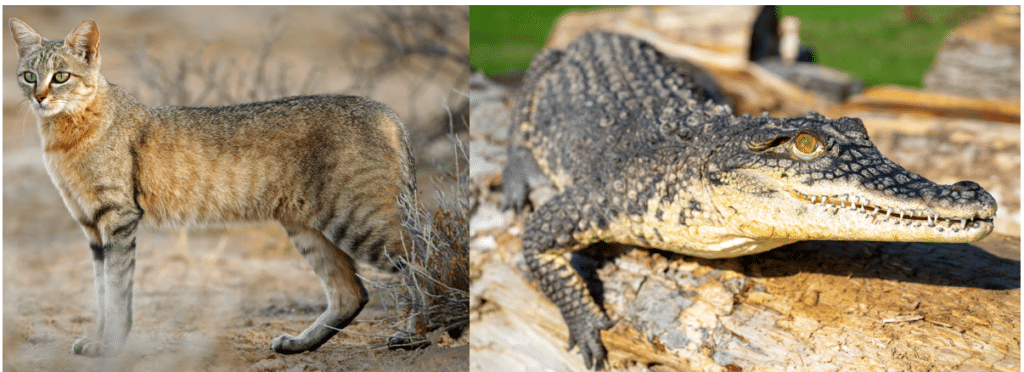3 Fierce PREDATORS found in Morocco! (2025)
What are the different kinds of PREDATORS found in Morocco?

These are often the first animals you think of when you imagine visiting Morocco! The exciting, beautiful, and sometimes terrifying carnivores are some of the most fun to learn about. 🙂
In this article, you’ll find interesting facts, photos, and even range maps of these amazing animals!
3 Predators Found in Morocco:
#1. African Wolf
- Canis lupaster

Identifying Characteristics:
- Adults stand about 40 cm (16 in) tall at the shoulder.
- They have relatively long pointed snouts and ears, comparatively short tails, and robust teeth.
- They’re yellowish to silvery gray with reddish legs, black speckling on their tails and shoulders, and some white markings on their faces, throats, and abdomens.
Look for this carnivore during the day in Morocco in grassland areas.
African Wolves have an extensive range, and their appearance and size vary with location. They usually center their territory around a den, often made from a modified aardvark or warthog den, where the female will have her pups.
African Wolves have flexible social structures that are largely dictated by prey availability. Each pack consists of a monogamous breeding pair that remains together constantly. It also includes current offspring and previous generations that help to raise their siblings.
These wolves can be formidable predators in Morocco, sometimes taking prey up to three times their own weight. However, they usually go after much smaller animals.
Pairs of wolves often hunt gazelle fawns and other small mammals like cane rats and ground squirrels. They also consume fruit, snakes, and insects. Interestingly, during the wildebeest calving season, African Wolves feed almost exclusively on wildebeest afterbirth.
#2. Fennec Fox
- Vulpes zerda

Identifying Characteristics:
- Adults are about 39 cm (15 in) long.
- They have massive, conical ears.
- Their coloration is buff on their upper bodies and white on their legs, faces, ear-linings, and undersides.
This predator is the smallest dog in Morocco!
They’re even smaller than most house cats, but don’t let their size fool you. Fennec Foxes are tough animals that live almost exclusively in sandy, arid regions.
Their massive ears help Fennec Foxes locate prey, even when it’s underground. They catch most of their prey by digging it out of the earth.
These omnivores live in a harsh environment and feed on anything they can get, including rodents, birds, eggs, lizards, insects, fruits, leaves, and roots. Plant materials are vital as they comprise 100% of the Fennec Fox’s hydration. Unlike most mammals, these foxes can live indefinitely without a water source.

Fennec Foxes are highly social animals that often live together in clans. Together these clans hold territories and dig burrows, which are used to raise pups and to shelter from the hot desert sun.
#3. African Wildcat
- Felis lybica

Identifying Characteristics:
- Adults are 46-60 cm (18-24 in) long.
- Coloration varies and may be tawny brown, sandy yellow, reddish, or gray with faint tabby spots and stripes, banded legs, and reddish or rusty-brown on the backs of their ears.
- They have long legs, small ear tufts, and long thin tails with a couple of rings near the end and black tips.
These predators in Morocco are the ancestors of the domestic cat!
While they’re also known as Desert Cats, they can be found in many habitats, including steppes, savannas, and bushlands.
African Wildcats are skillful hunters with incredible hearing. Once they’ve located prey, they slowly and sneakily approach it and pounce once they’re in range. They usually feed on mice, rats, and other small mammals.
African Wildcats are most active at night. During the day, they tend to avoid the heat and rest under bushes or other shelter, although sometimes they can be observed out hunting on cloudy, overcast days. Additionally, when threatened, these cats raise their hair to make themselves seem larger and intimidate their opponents, similar to what we see in domestic cats.
However, they have some distinctly wild traits. For example, when they sit upright, their long front legs raise their bodies almost vertically (more so than domestic cats). This posture can be seen on Egyptian bronze mummy cases and tomb paintings. They also have high shoulder blades that give them a distinctive cheetah-like gait.
Check out these other guides about animals found in Morocco!
-
50 Most Common Animals Found in Morocco!
-
The 3 MOST Common Birds in Morocco!
-
The 14 Types of Snakes That Live in Morocco! (ID Guide)
-
10 COMMON Spiders found in Morocco!
Which of these predators have you seen before in Morocco?
Leave a comment below!




